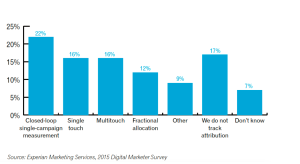Orange Juice
Your
quarterly
vitamin.
Marketing Attribution – Giving Credit Where It’s Due
Written on 02/23/16 4:50 PM
by Mara Schneider

What is Marketing Attribution?
Marketing attribution is the practice of determining the role that different channels play in informing and influencing the customer journey, and subsequently allocating partial value to different touch points which have influenced an action, purchase or another desired outcome.
Or to be put in another way, it is the practice of using advanced statistical approaches to allocate proportional credit to marketing communications and media activity across all channels, which ultimately leads to the desired customer action.
There are many different attribution models, each with their own merits, however, the most important element is to pick a model that fits company and marketing goals.
Currently, there are two popular models:
- Algorithmic Modeling (correlations, regressions, etc)
- Operational (analyzing all touchpoints that drive actions)
At RPM, we believe that the most effective attribution model is when all forms of communication are accounted for digitally and off-line (traditional). This enables a more holistic view of activities, and therefore the ability to encompass how individual activities can be better leveraged for the desired outcome. This includes promotions, partnerships, branding opportunities, digital and traditional advertising, websites, apps, call centers/customer service, community outreach, PR, philanthropic activities, and more.
While attribution started out as a “rules-based” approach and moved to “algorithmic” using formulas to assign conversion credit, the future of attribution is moving from “retrospective” to “predictive.” This means combining statistical predictive response models with econometric models to predict what will happen in the future, and therefore drive allocation of budget and resources toward the levers that truly impact business.
Why Organizations Are Moving Toward Attribution
As an essential part of the marketing process, there are numerous business reasons to implement attribution: to support marketing and advertising spend, to build an understanding of the customer journey and audience behavior, and to use this understanding to optimize the media mix.
Marketing and advertising attribution satisfies the desire to move beyond clicks, CTR, and straight conversions.
When marketers implement attribution, they often gain immediate insights that allow them to better adjust their budgets, moving money away from poorly performing channels and into more successful ones. This allows for a better strategy across the entire path to conversion.
It’s important to keep in mind that the advanced math used for attribution should not trump common sense and a marketing team’s personal and business observations when making planning and spending decisions. Attribution should be used as part of the overall marketing analysis and brands shouldn’t use it as the quintessential decision making tool.
The Science Behind Attribution
Although each attribution company has its own proprietary technology, many of them use a combination of the following mathematical modeling techniques:
- Simultaneous Equation Modeling
- Mixed Effect Models
- Regression Analysis: Parallel Bayesian Logit Regression
- Endogeneity Treatments
- VAR Models
- Mutually-exciting Point Process Models
- Hidden Markov Models
Regardless of the partner you choose, each company should be forthcoming and open to explaining their methodology and approach – no company should have a “black box” and be unwilling to share what’s inside. Even with this mathematical modeling, attribution is not perfect and the industry still has a long way to go in determining how consumers navigate through this complex consumer journey.
For Digital Attribution specifically, the models are broken out by:
- Last-Touch (or First-Touch): credit given to first click or last click
- Linear: Credit spread evenly throughout
- Multi-Touch
- Time Decay
- Position Based
- Regression or Algorithmic
The ideal scenario is to move away from single touch to closed-loop or multi-touch which takes into account the various ways that a consumer comes in contact with your brand or message.
How Marketers are Implementing Attribution

- Key: Closed-loop=Linear or Time Decay
- Single touch=Last touch or First touch
- Multi-touch=Regression or Algorithmic
- Fractional allocation=measuring only some channels
Are you ready for Attribution?
Typically, companies that implement attribution methods into their marketing activities can see a lift of 20-30% improvement in marketing effectiveness, 3-4% increase in revenue, and anywhere from 3x-50x increases in first year ROI. For most organizations, those are compelling numbers.
So where do you begin?
The first step, after understanding the role of attribution and evaluating potential partners, is to develop a roadmap. Work with chosen attribution partners to assess technology needs and the willingness to share data. Collaborate with internal marketing and CRM teams to identify the need and establish a purpose. Evaluate the goals of attribution and what it can accomplish for your organization.
Start small and learn to crawl, walk, run. Work towards incremental progress using more sophisticated metrics with each campaign. Look at all of the touchpoints where your organization is in contact with your customers. Make sure you understand each interaction.
Still think you’re ready for attribution? Then the ingredients for success are simple: get your data right, get your brand identity right, and get your math right.